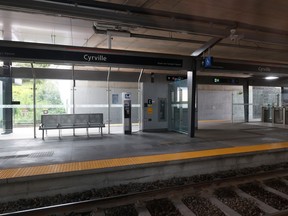“This fleet size in combination with the ongoing R1 bus service will provide the capacity required to meet current customer volumes.”
Published Jul 26, 2023 • Last updated 19 minutes ago • 3 minute read
 A file photo of Cyrville Station on the Confederation Line after LRT service was shut down on July 17. Photo by Tony Caldwell /Postmedia
A file photo of Cyrville Station on the Confederation Line after LRT service was shut down on July 17. Photo by Tony Caldwell /Postmedia
If the LRT returns to service on Monday as expected, the trains will look a little different.
Advertisement 2
This advertisement has not loaded yet, but your article continues below.
THIS CONTENT IS RESERVED FOR SUBSCRIBERS ONLY
Subscribe now to read the latest news in your city and across Canada.
Exclusive articles from Elizabeth Payne, David Pugliese, Andrew Duffy, Bruce Deachman and others. Plus, food reviews and event listings in the weekly newsletter, Ottawa, Out of Office. Unlimited online access to Ottawa Citizen and 15 news sites with one account. Ottawa Citizen ePaper, an electronic replica of the print edition to view on any device, share and comment on. Daily puzzles, including the New York Times Crossword. Support local journalism.
SUBSCRIBE TO UNLOCK MORE ARTICLES
Subscribe now to read the latest news in your city and across Canada.
Exclusive articles from Elizabeth Payne, David Pugliese, Andrew Duffy, Bruce Deachman and others. Plus, food reviews and event listings in the weekly newsletter, Ottawa, Out of Office. Unlimited online access to Ottawa Citizen and 15 news sites with one account. Ottawa Citizen ePaper, an electronic replica of the print edition to view on any device, share and comment on. Daily puzzles, including the New York Times Crossword. Support local journalism.
REGISTER TO UNLOCK MORE ARTICLES
Create an account or sign in to continue with your reading experience.
Access articles from across Canada with one account. Share your thoughts and join the conversation in the comments. Enjoy additional articles per month. Get email updates from your favourite authors.
Eight single-car trains will run every seven to eight minutes from Blair Station to Tunney’s Pasture Station. Customers can expect service to start and end on the normal service schedule. The R1 replacement bus service will continue to operate.
Article content
“With the eight single-car trains and the parallel R1 bus service, we can provide the capacity required to meet the customer volumes that we’re currently seeing in the system,” Troy Charter, the City of Ottawa’s director of transit service delivery and rail operations, said Wednesday.
The reason for the change to the trains is a new inspection regime that means axles will have to be replaced every 60,000 kilometres, not every 175,000 kilometres, as has been the practice.
Advertisement 3
This advertisement has not loaded yet, but your article continues below.
That means all of the 45-car fleet needs to have the axles replaced. Going forward, the trick will be ensuring that not all the axles must be replaced at the same time.
“We will be carefully managing out supply of vehicles to ensure there are enough ready to operate while also meeting the more frequent wheel assembly replacement requirements,” said Renée Amilcar, the city’s general manager of transit services.
“Once we can be assured that there is a sustainable number of vehicles for daily operation, we will assess the possibility of increasing the number of trains in service.”
The new inspection and replacement regime is to satisfy a draft safety note provided by Alstom, which manufactured the LRT trains, and the Rideau Transit Group (RTG), which maintains the rail transit system. Amilcar has previously stated the safety notes are to be reviewed and approved before the trains can run again.
Advertisement 4
This advertisement has not loaded yet, but your article continues below.
Article content
By Monday, 10 trains should be ready: eight in use and two on reserve. Each train can accommodate 300 people.
The new measures will remain in place until Alstom reviews the safety note. RTG can’t commit to a specific date to normal service at this point, but it will happen as soon as possible, general manager Enriquez Martinez Asensio said.
Staff in the transit operations control centre will monitor passenger volumes in the rail and bus systems and will be able to make adjustments, Charter said.
“But, ultimately, at the end of the day, our customers will have a choice to make if they want to take the rail line or they can take the bus service. That’s why we’re running both services in parallel: to give customers the option.”
Advertisement 5
This advertisement has not loaded yet, but your article continues below.
The problem-plagued trains were pulled from service late on the afternoon of July 17 after a routine maintenance inspection found excess grease on a train axle, and they have been out of service ever since.
OC Transpo and RTG conducted a risk assessment and confirmed that, since the system was originally designed to accommodate both single and double-car train operations, there were no additional risks to customer safety at station platforms, according to a memo released Wednesday.
Inspection of all 45 rail vehicles was completed July 24, with six vehicles requiring additional investigation. The “out of tolerance” axle hub that prompted the shutdown on July 17 is being analyzed, with a report on the findings expected Friday.
It will take two to three years before the problematic wheel hub assemblies can be redesigned and replaced.
Recommended from Editorial

Bogies, bearings and greasing the rails: Solutions for Ottawa’s beleaguered LRT

Phase 3 of Ottawa’s LRT won’t get built until Phase 1 and 2 are made reliable, premier says
>>> Read full article>>>
Copyright for syndicated content belongs to the linked Source : OttawaCitizen – https://ottawacitizen.com/news/local-news/new-inspection-regime-means-not-all-trains-will-be-available-when-lrt-resumes-service































